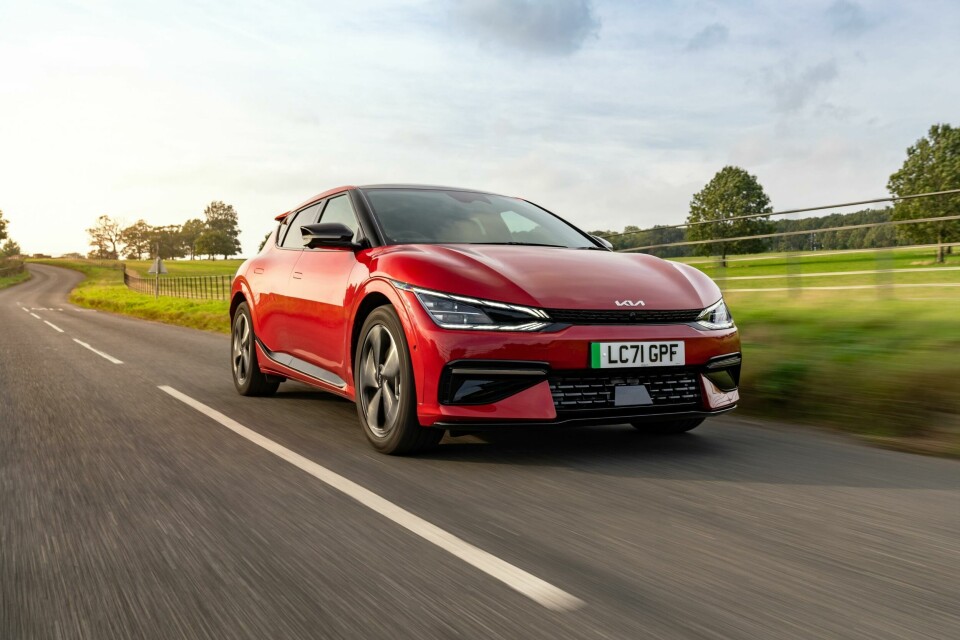
Driven: Kia EV6
Guy Bird gets behind the wheel of the EV6, hailing the model as Kia’s entry into the big league
We’ve been complimentary from afar about the Kia EV6 since its early 2021 unveil, but the plaudits have only been based on virtual impressions. So when the opportunity came to actually drive the large electric hatchback on British roads, Car Design News jumped at the chance.
Up close the car is no less impressive, although the more subtle silver and white colours perhaps suit its soft and stylish curves more than the bright red GT-Line S model in these photos. Still, the EV6 feels premium and modern in a way no previous Kia has truly managed, and from its hi-tech exterior lighting tech to its overall fit and finish, it appears more than capable of taking on the likes of Audi and BMW in the desirability stakes (let alone VW’s ID range).
The EV6’s bespoke E-GMP platform, shared with the Hyundai Ioniq 5 and Genesis GV60, allows for a long wheelbase between which can be housed plenty of batteries. The versions we drove all featured the larger 77.4kWh battery, one in two-wheel drive 229bhp guise good for 328 miles and a 325bhp AWD version which does 0-62mph two seconds quicker (5.2 vs. 7.3 secs) but still offers an anxiety-avoiding (and real-world) 300 miles of range. Compared to the Ioniq 5, the Kia is 55mm longer (4680mm), 55mm lower (1550mm) and with a 90mm shorter wheelbase (2900mm) but despite those big proportions the EV6 feels agile on the road and sight lines out of the front of the car are decent.
The high lip on the back means vision out of the rear window isn’t superb, but an array of cameras and sensors alleviate the issue. One helpful innovation in that area – featured first on sister brand Genesis’ new models – is a circular screen that pops up within the virtual driver display when the driver starts indicating left or right. Showing the real-time rearward view down the appropriate side of the car, where a driver’s blindspot would traditionally be, it’s helpful in reassuring that the way is clear before moving out of lane.
Physical wing mirrors remain on the EV6, but they are strikingly chamfered – for aerodynamic benefit – as is the three-prong roof spoiler. Below that, the large hatch reveals an equally large boot aperture that offers up to 490 litres with rear seats up, or 1300 litres seats folded flat (with an extra 52 litres in its ‘frunk’ on 2WD models or 20 litres on AWD versions). The car’s recharging port is also neatly integrated, in this case under a panel to the left of the right-hand rear light cluster. It’s a neat solution that means the EV6’s flush door-handled flanks have one less set of shutlines to hinder their visual flow.
Inside, the EV6’s cabin is genuinely spacious front and back, due to that 2900mm wheelbase, flat floor and uncluttered layout. Looking up can feel a bit dark though, with only a small sunroof available (rather than something more panoramic and light-channelling). The single curved dashboard display – made up of two 12-inch screens within one large unit – is pretty easy to use, and also to hook up Apple CarPlay or Android Auto. Climate control is altered at a separate bar below the main centre screen, anchored at each end by physical knobs for temperature. The controls in-between – from fan speed to rear and front de-mist, are all touch controls though – and can be a bit fiddly to adjust on the move (especially the fan). The air vent direction toggles are physical, slim but easily grabble and sit neatly within a horizontal fillet between the upper and lower IP.
Lower down still, within the centre console between driver and passenger, the auto gearshifter is round, proud and ribbed and the car’s on/off button pleasingly embedded and slightly protruding above the line of the console’s wraparound metal casing. Other less frequently used controls seem to be in slightly odd – or at least atypical – places. For instance, the touch controls for heating the steering wheel and seats are situated at the centre console’s end, and we failed to find the Drive Mode button (for eco, sport and normal settings), until day two of the test. Nestling just below the centre hub of the steering wheel to the left, it’s surprisingly easy to adjust, if you imagine the steering wheel as a timepiece and your left hand is positioned at ‘eight o’clock’. My old school driving instructor – who firmly suggested a ‘ten-to-two’ hands position at all times – might shudder at rewarding such a ‘casual’ approach though.
Colour and material options were fairly muted on all the EV6 options we drove, especially the entry-level Air trim. Its ambience felt a bit basic for a car starting at £40,945 (US$55,777.33). The top-end GT-Line S trim shown in these pictures, and starting from £51,945, is still greyly monochrome, but at least adds perforated suede seats with white vegan leather bolsters, contrast stitching and strangely-mounted, but modern-looking headrests.
Finally, external crowd reaction was muted (and limited in scope) on often sparsely-populated, rainy and rural East Anglian roads, but following various EV6s on the same test route – and seeing them static and re-charging among upscale large EVs including the stylish Jaguar i-Pace – the upstart Kia didn’t look out of place. Job done and welcome to the big league, Kia.

























